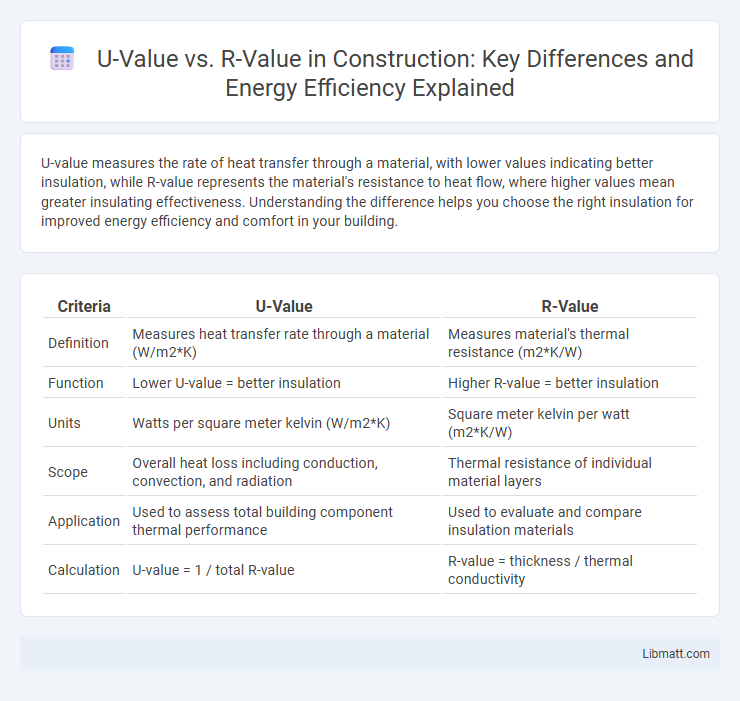U-value measures the rate of heat transfer through a material, with lower values indicating better insulation, while R-value represents the material's resistance to heat flow, where higher values mean greater insulating effectiveness. Understanding the difference helps you choose the right insulation for improved energy efficiency and comfort in your building.
Table of Comparison
| Criteria | U-Value | R-Value |
|---|---|---|
| Definition | Measures heat transfer rate through a material (W/m2*K) | Measures material's thermal resistance (m2*K/W) |
| Function | Lower U-value = better insulation | Higher R-value = better insulation |
| Units | Watts per square meter kelvin (W/m2*K) | Square meter kelvin per watt (m2*K/W) |
| Scope | Overall heat loss including conduction, convection, and radiation | Thermal resistance of individual material layers |
| Application | Used to assess total building component thermal performance | Used to evaluate and compare insulation materials |
| Calculation | U-value = 1 / total R-value | R-value = thickness / thermal conductivity |
Understanding U-Value and R-Value: Key Differences
U-value measures the rate of heat transfer through a material, indicating how well it conducts heat, with lower values representing better insulation. R-value quantifies thermal resistance and indicates a material's ability to resist heat flow, where higher values mean greater insulation effectiveness. The primary difference lies in their representation: U-value focuses on heat transfer rate, while R-value emphasizes resistance to heat flow.
Importance of Thermal Performance in Building Materials
Thermal performance in building materials is crucial for energy efficiency, with U-value measuring heat transfer rate and R-value indicating resistance to heat flow. Lower U-values signify better insulation, reducing heat loss and enhancing your building's comfort and energy savings. High R-value materials effectively prevent heat transfer, ensuring optimal thermal insulation to maintain indoor temperatures and reduce heating and cooling costs.
What Is U-Value? Meaning and Calculation
U-value measures the rate of heat transfer through a building material, expressed in watts per square meter per kelvin (W/m2*K), indicating how well a component insulates. It is calculated as the inverse of the R-value, which represents thermal resistance; thus, U-value = 1 / R-value. Lower U-values signify better insulation performance, essential for energy-efficient building design and thermal comfort.
What Is R-Value? Meaning and Calculation
R-value measures a material's resistance to heat flow, indicating its insulating effectiveness; the higher the R-value, the better the insulation performance. It is calculated by dividing the thickness of the material (in meters) by its thermal conductivity (k-value), expressed as R = thickness / k. Understanding the R-value helps you select materials that will improve your building's energy efficiency by minimizing heat transfer.
How U-Value and R-Value Relate to Insulation Efficiency
U-value measures the rate of heat transfer through a material, with lower values indicating better insulation efficiency, while R-value quantifies a material's resistance to heat flow, where higher numbers reflect superior insulation. Your choice of insulation should prioritize materials with a low U-value and high R-value to maximize energy savings and indoor comfort. Understanding how these metrics relate helps optimize building envelopes for thermal performance.
Comparing U-Value vs R-Value: Which Is Better?
U-value measures heat transfer rate through a material, with lower values indicating better insulation, while R-value quantifies thermal resistance, where higher values signify improved insulating properties. Comparing U-value vs R-value depends on application context: U-value offers a comprehensive metric for entire assemblies like walls and windows, whereas R-value is often used for individual materials. Choosing which is better requires understanding that U-value provides a more practical assessment of overall energy efficiency, especially in building design.
Global Standards: Where U-Value and R-Value Are Used
U-values, measuring heat transfer rate in watts per square meter kelvin (W/m2K), are the global standard for evaluating thermal insulation in Europe, Australia, and many Asian countries. R-values, representing thermal resistance in square feet-hour-degree Fahrenheit per British thermal unit (ft2*h*degF/BTU), are predominantly used in the United States and Canada for building insulation standards. Understanding the differences between U-value and R-value is essential for optimizing Your building's energy efficiency according to regional regulations and climate conditions.
Factors Affecting U-Value and R-Value Measurements
U-value and R-value measurements are influenced by material properties, thickness, and environmental conditions such as temperature and humidity. Your insulation's effectiveness depends on its density and moisture content, which can alter thermal conductivity and impact both U-value and R-value results. Accurate assessments require considering these factors to ensure reliable energy efficiency evaluations.
Common Applications in Construction
U-value measures the rate of heat transfer through building materials, making it essential for evaluating insulation effectiveness in walls, roofs, and windows. R-value quantifies resistance to heat flow, commonly used to specify insulation thickness in residential and commercial construction projects. Builders select materials based on U-value for overall energy performance and R-value for insulation properties, optimizing thermal comfort and energy efficiency in building envelopes.
Choosing Between U-Value and R-Value for Your Project
Choosing between U-value and R-value depends on your project's insulation goals and climate conditions, as U-value measures heat transfer rate while R-value indicates resistance to heat flow. For colder climates, prioritizing materials with a high R-value ensures better insulation, whereas U-value is more critical in regions requiring efficient heat loss or gain management. Understanding these values helps optimize energy efficiency and thermal comfort in your building design.
U-value vs R-value Infographic

 libmatt.com
libmatt.com